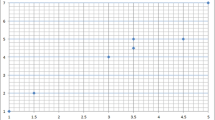Abstract
The possibility based clustering algorithm PCM was first proposed by Krishnapuram and Keller to overcome the noise sensitivity of algorithm FCM (Fuzzy C-Means). However, PCM still suffers from the following weaknesses: (1) the clustering results are strongly dependent on parameter selection and/or initialization; (2) the clustering accuracy is often deteriorated due to its coincident clustering problem; (3) outliers can not be well labeled, which will weaken its clustering performances in real applications. In this study, in order to effectively avoid the above weaknesses, a novel enhanced PCM version (EPCM) is presented. Here, at first a novel strategy of flexible hyperspheric dichotomy is proposed which may partition a dataset into two parts: the main cluster and auxiliary cluster, and is then utilized to construct the objective function of EPCM with some novel constraints. Finally, EPCM is realized by using an alternative optimization approach. The main advantage of EPCM lies in the fact that it can not only avoid the coincident cluster problem by using the novel constraint in its objective function, but also has less noise sensitivity and higher clustering accuracy due to the introduction of the strategy of flexible hyperspheric dichotomy. Our experimental results about simulated and real datasets confirm the above conclusions.
Similar content being viewed by others
References
Zhang D, Pal SK (2002) A fuzzy clustering neural networks system design methodology. IEEE Trans Neural Netw 11(4):1174–1177
Gustafson EE, Kessel WC (1979) Fuzzy clustering with a fuzzy covariance matrix. In: Proceedings of IEEE conference on decision and control, San Diego, pp 761–776
Chung FL, Wang S, Deng Z, Shu C, Hu D (2006) Clustering analysis of gene expression data based on semi-supervised visual clustering algorithm. Soft Comput 10:981–983
Dong G, Xie M (2005) Color clustering and learning for image segmentation based on neural networks. IEEE Trans Neural Netw 16(4):925–936
Timm H, Borgelt C, Doring C, Kruse R (2001) Fuzzy cluster analysis with cluster repulsion. Presented at the Europian symposium intelligent technologies (EUNITE), Tenerife, Spain
Timm H, Kruse R (2002) A modification to improve possibilistic fuzzy cluster analysis. presented at the IEEE international conference on Fuzzy systems, FUZZ-IEEE’ 2002, Honolulu
Timm H, Borgelt C, Doring C, Kruse R (2004) An extension to possibilistic fuzzy cluster analysis. Fuzzy Sets System, pp 3–16
Jian Yu (2005) General C-means Clustering Model. IEEE Trans Pattern Anal Mach Intell 27(8):1197–1211
Zhang JS, Yeung YW (2004) Improved possibilistic C-means clustering algorithms. IEEE Trans Fuzzy Syst 12(2):209–217
Bezdek JC (1981) Pattern recognition with fuzzy objective function algorithms. Plenum, New York
Cinque L, Foresti GL, Lombardi L (2004) A clustering fuzzy approach for image segmentation. Pattern Recognit 37(9):1797– 1807
Yang M-S, Wu K-L (2006) Unsupervised possibilistic clustering. Pattern Recognit 39(1):5–21
Moghaddamzadeh, Bourbakis N (1997) A fuzzy region growing approach for segmentation of color images. Pattern Recognit 30(6):867–881
Barni M, Cappellini V, Mecocci A (1996) Comments on “A possibilistic approach to clustering”. IEEE Trans Fuzzy Syst 4:393–396
Sato M, Sato Y, Jain LC (1997) Fuzzy clustering models and applications. Physica-Verlag, New York
Pal NR, Pal K, Keller JM, Bezdek JC (2005) A possibilistic fuzzy c-means clustering algorithm. IEEE Trans Fuzzy Syst 13(4): 517–530
Dave RN, Krishnapuram R (1997) Robust clustering methods: A unified view. IEEE Trans Fuzzy Syst 5(2):270–293
Dave RN, Sen S (2002) Robust fuzzy clustering of relational data. IEEE Trans Fuzzy Syst 10(6):713–727
Krishnapuram R, Keller JM (1993) A Possibilistic approach to clustering. IEEE Trans Fuzzy Syst 1(2):98–110
Krishnapuram R, Keller JM (1996) The possibilistic c-means algorithm: insights and recommendations. IEEE Trans Fuzzy Syst 4(3): 385–393
Wang S, Chung F-l, Xu M, Hu D, Qing L (2005) Possibility theoretic clustering. Lecture Notes in Computer Science, vol. 3644
Wang ST, Chung FL, Deng ZH (2006) Robust maximum entropy clustering algorithm with its labeling for outliers. Soft Comput 10: 555–563
Tobias OJ, Seara R (2002) Image segmentation by histogram thresholding using fuzzy sets. IEEE Trans Image Process 11(12): 1457–1465
Deng ZH, Wang ST (2005) Robust fuzzy clustering neural networks. Chin J Softw 16(8):1415–1422
Author information
Authors and Affiliations
Corresponding author
Rights and permissions
About this article
Cite this article
Xie, Z., Wang, S. & Chung, F.L. An enhanced possibilistic C-Means clustering algorithm EPCM. Soft Comput 12, 593–611 (2008). https://doi.org/10.1007/s00500-007-0231-6
Published:
Issue Date:
DOI: https://doi.org/10.1007/s00500-007-0231-6




